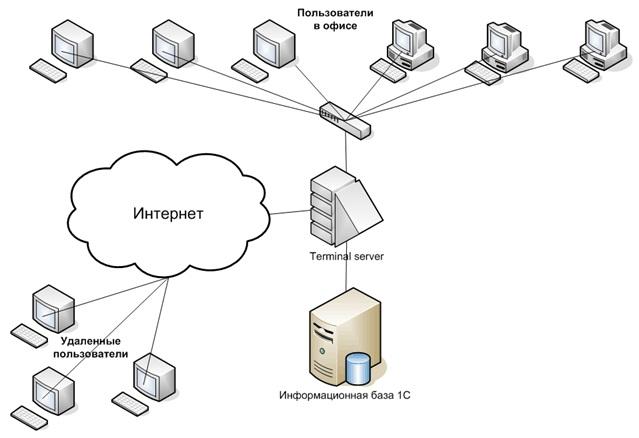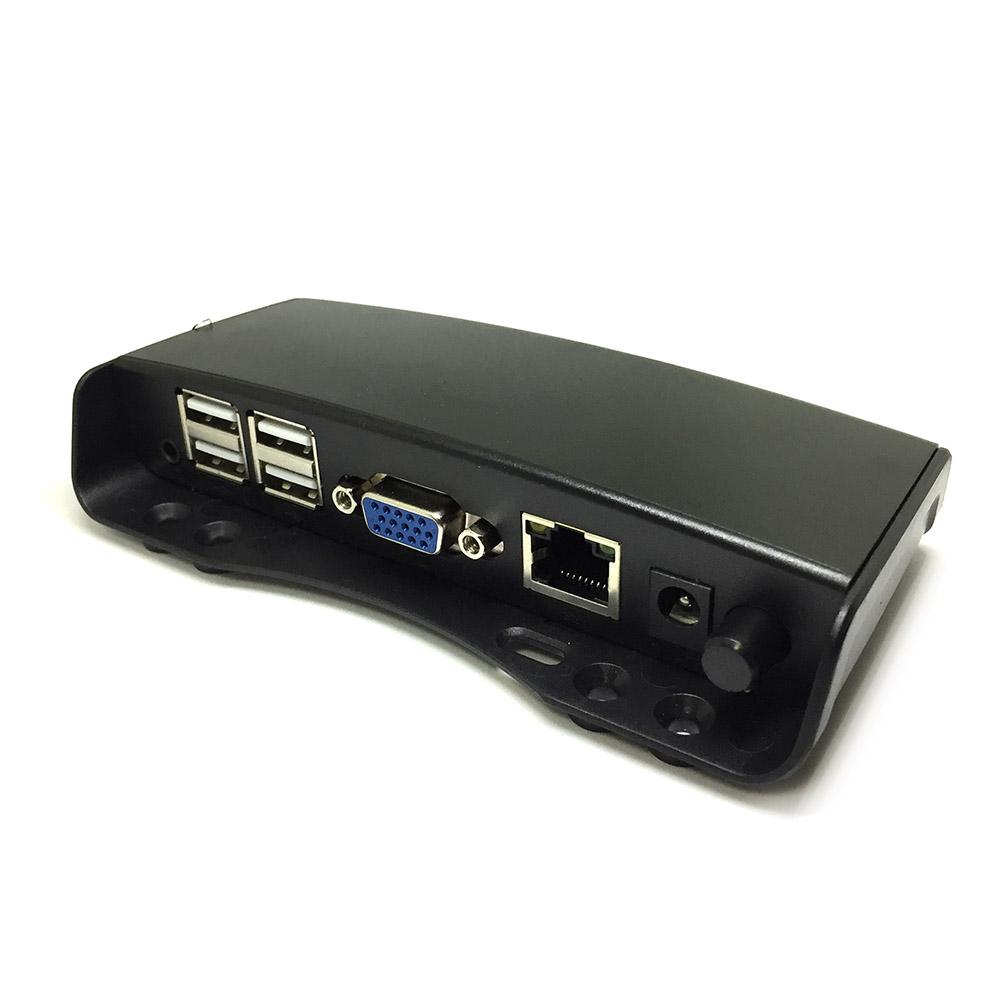A terminal server is a device that provides remote access to desktops, delegating computing resources to the end user. It differs from a virtual server in that it does not create a separate virtual machine, but provides a working session on the current system.
It is used with specialized software that supports remote session work. In 2025, the technology remains relevant because it allows for cost savings and maximizes benefits.
It’s time to talk more about the terminal server, as the application of such a hardware-software complex is widespread. Sometimes it’s simpler to create one powerful unit of equipment and set up dozens of remote desktops than to use numerous personal computers, which complicates maintenance and administration.
Purpose of a Terminal Server
Let’s assume the following situation: there are 10 company employees who need to work with Word, Excel, send emails, and process orders in the CRM. Occasionally, they also need to work with 1C. Of course, you could buy a PC for each employee, but what kind of investment would that require? Additionally, Windows would need to be installed on each computer, and they would require periodic maintenance. It’s full of complexities.
More licenses would be needed, as well as more overall computing power and personal computers, which would significantly increase the cost of the technical infrastructure.
There is a simpler way to solve the problem:
- Create a central node, which will be the terminal server;
- Allow user access to it;
- Allocate exactly as much power as needed to complete the task.
As you can see, a terminal server allows you to solve the problem simply and straightforwardly. You set up one powerful server, create 10 user accounts for the employees, set up thin clients, and give access to the employees. Just keep in mind that you need to ensure a few important things:
- Network bandwidth;
- Processor resources;
- Amount of RAM;
- Disk memory.
As you can see, only a minimal number of factors need to be considered, but other issues may arise—such as licenses. There is an approach that allows you to save a lot if you decide to act legally. I’ll talk about them at the end of the article.
Of course, it’s also important to approach administration wisely, properly assigning user rights and addressing potential vulnerabilities.
Technology
The requirements for the device will vary depending on the number of users, operating system, and software requirements. Let’s go from simple to complex. We’ll start with the software requirements.
This depends on the type of guest sessions. For example, each desktop may initialize a separate process, which will consume the specified amount of computing resources, such as Adobe Acrobat has encountered this problem. Rendering processes when displaying pages, 2D graphics acceleration, and different types of anti-aliasing worked separately for each remote desktop, which negatively affected performance. This problem is still observed today.
The second type is when terminal access is provided not by running separate desktops but by creating separate sessions within one application. For example, web servers are built this way; they run under one OS but create different sessions within themselves.
So, first of all, you need to find out how much resources each process will consume. In fact, you will have to calculate the total consumption of each desktop. This is quite a complex task.
Now, about the operating system. In general, it’s quite difficult to cover this topic in an article; there are dozens of OSs, the most common of which are:
- Unix-like, the most popular of which belong to the Linux subtype;
- Windows, including server versions;
- BSD, also a UNIX-like system but has undergone significant changes;
- Many others, such as custom ones tailored for specialized tasks.
Each OS will have its own requirements and different capabilities for providing terminal access. The device requirements will vary significantly depending on the type of operating system.
And finally, the number of users is the most important because the number of simultaneous sessions will determine the final requirements for the terminal server. Each person is a potential remote desktop. You will have to take this into account when creating the technical infrastructure.
Additionally, each user needs to be given as much power as required for their work. Sometimes terminal servers are mixed with virtualization.
A cluster of servers is combined, several virtual servers are created for different tasks, and then terminal access is given to end users.
Technical Requirements
Have you seen what you have to deal with? Great. I hope you understand that I can’t cover all possible configurations for every task. I can only talk about the ones I’ve implemented myself. But I’ve always encountered a few problems that should be given attention when creating a terminal server.
When designing a terminal server, always consider this simple fact: it’s better to allocate a separate CPU thread for each desktop, or even better, a separate core.
For example, if there are 20 users, it is recommended to use at least a 10-core CPU with 20 threads, or better yet, a 20-core processor. But this depends on the application requirements. If it’s just an office used by employees, that’s fine. But if the users are heavily involved in programming and periodically run compilers, each employee can consume a lot of resources.
The disk subsystem is a weak link in a terminal server if it is heavily used for file operations. For example, if users run different applications but they are all on one disk. Use RAID, install SSDs, and distribute applications across different drives. Make sure that one HDD is not overwhelmed with numerous accesses. It’s better to allocate a separate disk for every 2-4 sessions. Use SSDs for these tasks if the volume is sufficient.
RAM. If 64 GB is required for all users, it is a big mistake to install 2 modules of 32 GB each. Ideally, RAM should also be split, so the number of accesses to the modules doesn’t become critical.
Break it down into 16 GB modules; this will be more reliable. But consider the maximum number of slots. If there are only 4 slots and you plan to have 128 GB, then you’ll have to use 32 GB modules.
Network card. A very serious problem! Why? Because 1GbE is simply not enough for a large number of connections. Not because the channel is clogged, but simply because it doesn’t parallelize. Most servers now support 10 and 100 Gbps; it’s better to use such network cards.
Get cards that support independent channels to avoid problems. Two, or better yet, four.
Power supplies should ideally be hot-swappable; otherwise, if one fails, the device will lose power. Don’t forget to get a good uninterruptible power supply. In the event of a power outage, this will give you time to properly shut down, saving all data. The rest is up to you. However, I can suggest a few complete builds that you can order. I’ll base everything on Supermicro to avoid overpayments. I won’t specify the price as it fluctuates constantly, like hope jumping off a skyscraper.
Thin Client
What should be used to work with a terminal server? That’s right, any device that can handle data input and output:
- An old computer;
- A tablet;
- An all-in-one;
- A specialized device.
In general, a thin client can be anything that can access a terminal session. Often, specialized “boxes” with minimal computing power are purchased for this purpose.
They simply output data to a monitor and read and send input data. Nothing more. They do not process information themselves. But in this case, a graphics card needs to be installed on the terminal server because the device won’t be able to process graphics on its own.
Thick Client
Essentially, a regular PC. Yes, a thick client refers to a device that works together with a terminal server. For example, the server handles data processing, while the thick client handles graphical display or rendering.
A useful combination, but not always effective. Usually, it’s the opposite: it’s better to handle complex tasks like rendering, working with graphics, and cloud computing on a workstation or server, and use the PC for simpler tasks.
But if a PC is sufficient for the task, then a thick client can be used in conjunction with a terminal server.
Licensing
Now, about something very important. In the case of a terminal server, the licensing is somewhat different. On one hand, it can be advantageous, but on the other, not so much. Let’s look at the standard types of licenses for such a technical infrastructure:
- Per Seat License. This is not the most advantageous option because there may be several dozen employees, but no more than 10 will be working with the application simultaneously. If everyone is working without exception, then a separate license for each seat can be obtained.
- Per User License. This type of license covers a certain number of concurrent users. No more users than specified, but fewer is possible. If employees use the software periodically and take turns, this becomes a very advantageous option. However, this option doesn’t work as well with individual PCs.
- Per Connection License. This is a very rare type of license that I haven’t seen in practice yet, but the principle is similar to the above, with the restriction being the number of concurrent sessions.
So, if you need to save on software and not install it on each computer individually, using a terminal server offers significant flexibility in licensing.
Terminal Server Builds
Now, let me tell you a bit about suitable builds. These can be used at the moment.
Option 1

Plattform: Supermicro SuperServer SYS-511R-M
CPU: 1 x Intel Xeon Processor E5-2420
RAM: 3 x 8 GB HPE ECC Registered (500662-B21/501536-001)
SSD: 2 x SSD 870 QVO 4 TB
HDD: 2 x Toshiba S300 HDWT380UZSVA 8 TB
This build would be suitable for a simple 1C server with a disk subsystem consisting of 2 SATA-interface SSDs combined in RAID 1, as well as a disk storage of 2 HDDs for storing various scanned files, also in RAID 1. The server supports up to 6 sessions and requires thin clients with dedicated graphics cards for operation.
Outdated components are being used to save money.
Option 2

Platform: Supermicro SuperServer SYS-621P-TR
CPU: 2 x Intel Xeon Silver 4510
RAM: 4 x 16 GB Kingston ECC (KSM48E40BS8KI-16HA)
SSD: 8 x Kingston DC600M 3.84 TB SSDs with 2.5 adapters
A terminal server for 50 users for IP telephony and customer database management. 8 SSDs are used to create 2 separate RAID 10 arrays, one used for user tasks and the other for the database. The backup server is separate.
Thin clients with dedicated graphics cards are required for operation.
Option 3

Platform: Supermicro SuperServer SYS-220HE-FTNRD
CPU: 2 x Intel Xeon Gold 5317
RAM: 8 x 16 GB Supermicro (Micron) (MEM-DR416MB-ER32)
NVME: 6 x Solidigm D7-P5520 3,84 TB
GPU: 3 x NVIDIA A40
A terminal server for CAD work and architectural calculations for 3 users. The device’s power is even excessive. It comfortably allows multiple CAD users to work, and the 3 NVIDIA A40 graphics cards can be fully utilized only during calculations.
A terminal server is a good solution for business
Fewer computers, centralized maintenance. This format is much more convenient than using individual computers. And, often, even cheaper.
I hope I have clearly explained everything about terminal servers. With this, I bid you farewell, wish you all the best, and much success!


